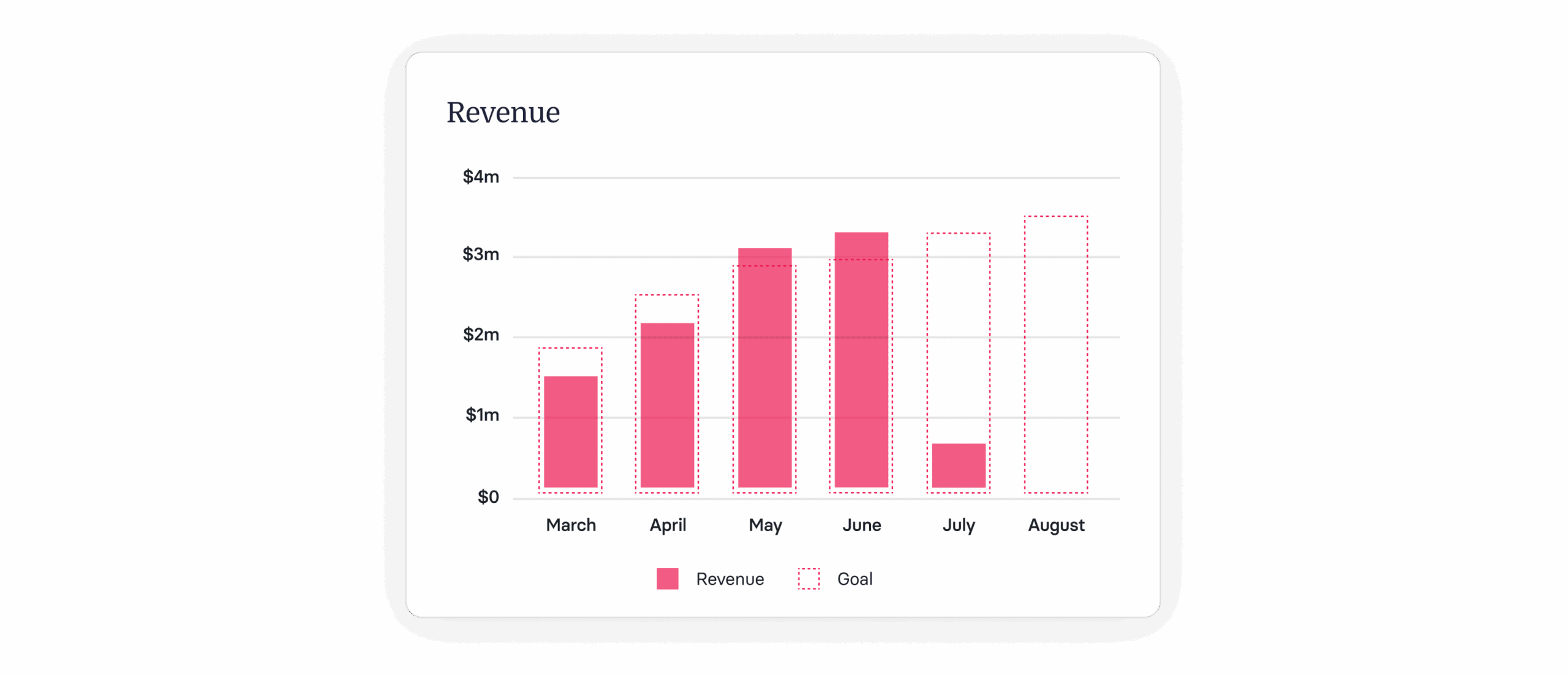Projected revenue is an essential financial planning tool that estimates future income based on historical data and assumptions.
What is projected revenue?
Projected revenue is an estimate of how much money a business expects to earn over a specific period—whether that’s a month, a quarter, or a full year.
It plays a central role in financial planning, budgeting, and guiding strategic decisions about where to invest time and resources.
<<Download the SaaS metrics cheat sheet.>>

Projecting revenue from multiple sources—like monthly subscriptions, annual contracts, and one-time purchases—is complex, but essential. These forecasts shape everything from a SaaS company’s valuation to its ability to make smart, forward-looking decisions.
Companies that develop disciplined, reliable revenue projections set themselves up for steady, sustainable growth. And while perfect accuracy isn’t the goal—because that’s rarely realistic—getting serious about revenue forecasting early on gives your business a strong foundation for making informed, confident choices.
Key insights
- Projected revenue is an essential financial planning tool that estimates future income based on historical data and assumptions
- Accurate revenue projections support strategic decision-making, investor confidence, and effective expense planning
- SaaS companies benefit from reliable projections, enabling them to manage cash flow, secure funding, and maintain a steady growth trajectory
- Understanding the distinction between revenue projections and forecasts is crucial for effective financial management
Why SaaS companies need to project revenue effectively
Let’s start by clarifying two terms that often get mixed up: revenue forecasting and revenue projections.
Like sales forecasting, revenue forecasting estimates how much revenue a company expects to bring in during a set period, based on historical data and trends.
Revenue projections, on the other hand, are used in “what-if” scenarios. They estimate potential revenue under different sets of assumptions—making them especially valuable for cash flow management, fundraising, budgeting, resource planning, valuation, and risk mitigation.
The distinction is subtle, which is why the terms are often used interchangeably. But for this guide, we’re focusing specifically on revenue projections.
In publicly traded companies, revenue projections—including metrics like revenue run rate—act as a form of financial guidance for investors. But they’re just as important for early-stage companies.
For SaaS businesses in particular, high upfront costs in areas like customer acquisition, development, and infrastructure often precede actual revenue. Accurate projections help navigate those early cash flow challenges, identify high-performing offerings, prioritize business efforts, and manage risk effectively.
<<Download the 2024 financial planning blueprint.>>
Furthermore accurate projections can help you:
Recommended For Further Reading
Build investor confidence
For VC-backed SaaS companies, meeting key milestones between funding rounds is critical. Consistently delivering on revenue projections helps build investor confidence—showing that you have a clear grasp of your business and that their investment is well-placed.
When investors see reliable performance and steady progress, they’re more likely to support future funding rounds and continue backing your growth.
Support expense planning
Expense planning plays a major role in shaping your company’s cash flow, profitability, and growth. And it all starts with your revenue projections.
By modeling different revenue scenarios, you create a foundation for your broader financial plan—including how much you’ll need to spend to reach your goals. That’s where spend forecasting comes in.
If your revenue projections are inaccurate or inconsistent, the rest of your planning quickly unravels. A disconnect between projected income and actual expenses can lead to cash flow issues and make it harder to stay on track.
Enable agile decision-making
Accurate revenue projections are key to making smart, timely decisions—and keeping your company on a stable, predictable growth path. The more efficiently you can build and adjust your projections, the easier it is to adapt when market conditions shift.
For example, quarterly or even monthly reforecasting can be a powerful tool when the landscape is uncertain. Based on recent actuals, where do you expect to land by year-end? How does that compare to your original plan? And most importantly—what steps can you take now to close any gaps?
Having a clear view of projected revenue helps you answer these questions early, so you can address potential issues before they become real obstacles.
Projected revenue FAQs
Is a revenue projection the same as a forecast?
While revenue projections and forecasts are closely related, they serve different purposes.
Revenue forecasts are grounded in current trends and assumptions—essentially a prediction of what’s most likely to happen over a set period, like the fiscal year. A financial forecast outlines how planned business activities are expected to impact your company’s financial statements.
Revenue projections, by contrast, explore “what-if” scenarios. They’re more speculative, allowing you to model different financial outcomes—like best-case or worst-case situations—even if those scenarios aren’t expected to materialize. This kind of analysis helps you prepare for uncertainty and build more resilient plans.
Can you calculate projected revenue in Excel?
While it’s possible to calculate projected revenue in Excel using historical data and linear regression, spreadsheets can be error-prone and time-consuming—especially for finance teams operating in fast-moving markets. And when you factor in the complexity of the SaaS business model, manual processes become even more challenging.
That’s why many teams turn to purpose-built financial planning tools. These platforms streamline the process, support more accurate projections, and give you the flexibility to adapt quickly as conditions change.
What is the difference between projected and actual revenue?
Projected revenue is an estimate of how much a company expects to earn in the future, based on historical data and specific assumptions. It’s a valuable planning tool—helping teams make informed decisions before the actual numbers are in.
Actual revenue, on the other hand, reflects the real income a company generates during a set period, typically through sales of products or services. It’s recorded after the fact and used to assess performance against projections and forecasts.
